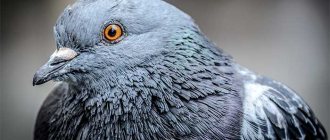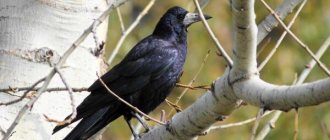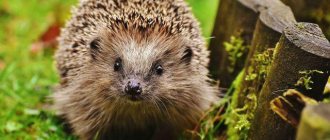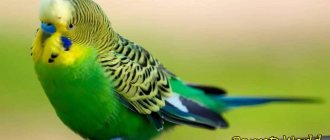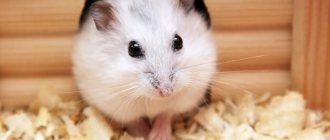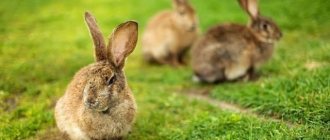Canary: description
Canaries represent the only subspecies of finches that are famous for their unusual singing.
Appearance
The domestic canary, compared to its wild relatives, is somewhat larger in size. As a rule, most ornamental canary species have a body length of 15 cm maximum. At the same time, there are species that differ in either larger or smaller values.
These birds have a fairly harmonious body shape, with an equally harmoniously built round head. The bird's beak is short and pin-shaped. The main color of most song canaries is yellow.
Despite this fact, in our time it is possible to purchase a bird with an original color without any problems. If a canary has red feathers, it means it is the result of crossing with a fire siskin.
It should also be noted that in our time there are other artificially bred forms of canaries, with the presence of a visible crest or various curls. The flight pattern of this domestic songbird is similar to that of wild birds.
Lifestyle and behavior
The world first learned about the wild canary from the famous German naturalist Karl Bolle a little over a hundred years ago.
This interesting bird, small in size, prefers to live in sparse thickets of vegetation, in bushes, and also within forest edges. At the same time, the bird cannot be found in places where shade from dense green spaces predominates. Canaries can be found in gardens, as well as in close proximity to human habitation.
When the non-nesting period of life for birds begins, they prefer to stay in small groups, in which they fly from tree to tree in search of food. Being in the wild, these birds feed on the seeds of various herbs and plants, greens, as well as various types of berries, including grapes, both wild and cultivated. Most of all, these birds love to feast on poppy seeds and garden salad, as well as partially ripened “canary seeds”.
During the period of feeding their chicks, birds prefer to hunt various insects, such as scale insects or green aphids. Before sunset, these birds form numerous flocks and go to roost for the night, choosing one of the tallest trees.
Interesting to know! In February/March, the mating season begins for canaries. During this period, groups or flocks break up and pair formation begins, after which the birds begin mass formation of nests.
Canary - All about the bird species | Type of bird - canary
Life on the islands
Wild canaries have to look for food every day. On the Canary Islands, where they come from, there is an abundance of plant food, which the birds feed on. Constant access to fresh food directly from the bushes and fields, as well as a climate without sharp temperature fluctuations, have a beneficial effect on their health. It would seem that the birds can live and live for their own pleasure, but...
Many predators lie in wait for small birds day and night, eager to feast on them. During daytime migrations, canaries become targets for owls, royal kites and other birds of prey. At night, sleeping canaries can be attacked by bats, which can see well in the dark.
Dangerous rats and cats, which were brought to the Canary Islands from Europe, are running around the earth. They destroy bird nests and eat chicks. Sometimes enemies lie in wait for babies during their first flights. In addition, rats are carriers of infections. A sick bird can infect the entire flock, and sick individuals do not live long.
As a result, wild canaries that manage to fly away from their parent’s nest live a maximum of six to eight years. The luckiest birds sometimes live up to ten years.
Types of canaries with photos and names
There are several varieties of song and ornamental canaries that are suitable for keeping in captivity. The most common decorative types include:
Belgian Fancy Canary
The peculiarity of the bird is that it has a characteristic vertical type of posture and a strongly lowered head.
Yorkshire Canary
Yorkshire canary, which is characterized by a slightly larger size, as well as a body shape similar to a carrot.
Border Fancy Canary
This is a small bird, with brilliant plumage, and also undemanding in maintenance.
Fife Fancy Canary
In appearance, this canary is similar to the Border canary, but at the same time has a slightly smaller body size.
Crested Canary
Which differs in that it has several longer and raised feathers on its head, giving the impression of having a crest.
Norwich Canary
This is a bird characterized as large and massive, with a dense build and original appearance.
Staffordshire Canary
It has a very bright and attractive plumage, which is dominated by bright red or contrasting pink shades.
Lizard Canary
The color of this bird has an original speckled coloring, reminiscent of the scales of a lizard.
Parisian Frilled Canary
It is considered the largest variety and the most popular. It is distinguished by the presence of curly plumage, as well as legs twisted in the form of a corkscrew.
Mehringer Frill Canary
It is completely similar in appearance to the Parisian Curly Canary, but at the same time has a much smaller size.
The purpose of breeding the domestic song canary was to improve the natural singing characteristics of male canaries. Canaries have the ability to reproduce many sounds and even primitive melodies, regardless of the variety. Depending on the species, canaries are capable of making the following sounds:
German Roller Canary
This is a singing canary that produces low-pitched voices and is therefore characterized by a quiet sound. She can also make sounds without opening her mouth at all. At the same time, when playing sounds, intermittent, sharp sounds may appear, which are not very pleasant, which is a disadvantage of this variety.
Belgian Malinois (Waterslager Canary)
The Belgian song canary has an attractive appearance and a pleasant voice. Its singing consists of sounds reminiscent of gurgling, gurgling and bubbling together with nightingale trills.
Spanish Timbrado Canary
The Spanish song canary easily performs three song tours in a strictly defined sequence, as well as with a metallic tint.
American Singer Canary
Represents the American song canary. This variety was released after crossing the German Roller and the Border canary. The bird has a beautiful appearance and a pleasant, melodic and loud sound.
Interesting to know! The singing Russian canary is also very popular. The basis of her singing is the trills of the tit, the common bunting, and the dubrovnik.
How long do canaries live?
The lifespan of a songbird directly depends on the conditions in which it is kept, and it is very important to maintain the correct temperature, lighting and humidity. In such conditions, a canary can live up to 12 years. It should be noted that there are individuals that have lived for 15 years.
Canaries. Daily care and maintenance
Reproduction
After selecting a pair , a special nest is installed. Then the birds are provided with material for making soft bedding: hay, fine straw, dry moss, pieces of cotton fabric. When the pets have prepared the nesting bedding, dry chamomile leaves or filter bags are placed under it. The antibacterial effect of chamomile will rid birds of parasites.
The female will lay the first egg 10-12 days after sexual intercourse. Then laying occurs every day, usually a couple has up to 5 testicles. After the first egg appears, it is replaced with a wooden one. This is done with each subsequent testicle until the last one. When the female lays the last egg, all those previously taken are returned to the nest. If the eggs are not replaced, the chicks will appear on different days, which will lead to the danger of death of the youngest ones.
Eggs should be removed from the nest with a spoon, not with your hands, so as not to crush them. Store in a box with soft litter. The female incubates the eggs for two weeks . Birds begin to feed their offspring within a day, some, especially caring parents, after a few hours.
Food for chicks in the first days consists of a hard-boiled egg, finely chopped and mixed with white grated breadcrumbs. After 3-4 days, porridge is added to the diet. Porridge is cooked from rice and millet in milk with the addition of eggs. The food must be stored in the refrigerator.
It’s easy to prepare porridge:
- boil a glass of water;
- pour a teaspoon of cereal into a glass and cook until the cereal is boiled;
- add 150 grams to the boiled cereal. milk;
- after the milk boils, add 3 teaspoons of cereal and cook;
- Salt the cooked porridge and pour an egg into it.
As the chicks grow, the volume of prepared food increases..
A week later, the canar joins in caring for the offspring. On the eighth day the chicks open their eyes, on the twelfth the chicks try to fly out of the nest. Then the canary takes full care of the children, as the female must prepare for the next clutch and incubation of eggs.
After the ability to fly has been established, the chicks are fenced off from their parents with a lattice. In this case, the female and male will feed the young through the bars. The need for separation is due to the fact that, while remaining together, the adults pluck the babies. After two weeks, the chicks are completely independent: they can fly and eat a mixture of grains. Kenars are placed in one cage, females in another and transferred to the normal feeding regime.
After three weeks, the kenara begins to try to sing. The songs of young birds are not as beautiful as the trills of adult birds, but they make it possible to separate males from females. Females do not sing.
One of the breeding methods is keeping one male with two females. This option creates a serious burden on the female. Breeding in pairs produces healthier offspring and is easier for birds to tolerate.
Colored canaries are bred in the same way as songbirds, but they require more attention . Attention should be paid to the selection of individuals for mating. For example, two intensely colored red birds will produce weak offspring with sparse feathers. On the contrary, individuals with a pale color will give birth to healthy chicks with bright colors and beautiful appearance.
Crossing a pale individual with a brightly colored one is allowed, no matter who has the more intense color - the female or the male. Part of the brood will take the father's data, part - the mother's data, there is a possibility of the birth of defective chicks.
Keeping a canary at home
Canaries are birds that can be “trained”, they are easily tamed and very trusting. They reproduce without problems in captivity. They can be kept both in cages and in special enclosures.
Selecting a cage and filling it
Choosing a cage for a canary is quite a responsible task. The best option is a hutch made from hardwoods such as oak, beech and ash. A good option is a metal cage that is easy to clean and disinfect.
Increasingly, canaries are kept in peculiar houses made of organic glass and which have basic dimensions of 30x35x20 or 22x27x29 cm. The distance between the rods can be no more than one and a half centimeters. Designs with side doors are better suited for keeping such birds. In this case, it is desirable that the model have a double bottom, with a retractable part.
Alternatively, feeders can be placed directly on the bottom of the cage, although in this case the feed may quickly become clogged. A more current filling option could be a perch with a rough surface and a round shape. In the case of group keeping of poultry, you should opt for cage cages, as well as spacious flight cages.
These birds love water treatments, especially since frequent bathing helps cleanse the skin and strengthen the plumage. Birds should take water procedures in conditions where the water temperature matches the ambient temperature.
The bathing suit should be secured to the outside of the door so that water cannot get inside the cage during bathing. At the end of the water procedures, it is better to remove the bathing suit and close the door. The bird should be accustomed to this important process from an early age.
Important point! The cage should be in good lighting conditions, but under no circumstances should it be in direct sunlight. The cage should not be placed in a draft area. In an enclosed space, it is necessary to give the canary the opportunity to fly.
Care and hygiene
The cage must be cleaned at least 2 times a week. During this period, the bird should be placed in a temporary cage, and a clean one. The cleaning process should consist of thoroughly washing all elements of the cage with hot water. After this, they are scalded with boiling water and disinfected with a strong infusion of chamomile. After this, all elements are wiped dry and dried. Dry chamomile should be poured into the area of the cell tray, and dry, clean river sand should be poured onto the tray itself, and a thin layer of eggshell on top. The shell will serve as a kind of feeding for the birds, as a result of which the digestion process improves. Feeders are filled with food. Clean water at room temperature must be present.
What to feed a canary
Ornamental birds feed 2 times a day, morning and evening at certain times. In the morning, birds should be fed soft food, insects and other food mixtures. The basic diet consisting of vegetables, fruits and herbs is given every evening. The nature of the food depends on the species characteristics of the birds, as well as on the time of year. In the case of keeping several birds, it is natural that the diet should be increased.
In case of improper feeding, poultry may develop metabolic disorders. As a result, birds may experience feather loss. To prevent this from happening, your pet should be accustomed to eating different types of food from an early age. When the breeding process begins, the quantity of food, as well as its quality, increases. At the same time, highly nutritious components must be present, including vitamins and minerals.
As a rule, the daily dose of feed is determined experimentally and depends on the individual characteristics of the birds and their appetite. Recommendations from experienced canary owners include the following dietary indicators. For a canary for a day it is enough:
- Grain mixtures – 20 g.
- Half an apple.
- One tablet of calcium gluconate or glycerophosphate.
- One fresh cabbage leaf.
- One teaspoon of grated carrots.
- Two teaspoons of chopped chicken egg.
- One glucose tablet.
- Cool millet, buckwheat or rice porridge – 5 g.
- One slice of white bread or cracker.
- Two teaspoons of milk to soak white bread.
- One teaspoon of fresh cottage cheese.
With the onset of winter, the diet should be expanded by introducing fish oil and brewer's yeast into the diet. To minimize the chances of various negative health manifestations, your pet’s diet should be as balanced as possible. It must be remembered that it is not recommended to feed these birds twigs of oak, pear, poplar, conifers and bird cherry.
Health, disease and prevention
If a canary gets sick, it needs to be placed in a separate cage for quarantine.
The most common and widespread diseases of canaries include:
- The appearance of growths on the paws.
- Intestinal blockage.
- Constipation and diarrhea.
- Qatar of the upper respiratory tract.
- Colds.
- Metabolic disease.
- Receiving injuries, fractures and wounds.
- Goiter inflammation.
- Avitaminosis.
- Paratyphoid.
- Liver dysfunction.
- Tuberculosis.
- Diphtheria.
- Losing my voice.
- Loss of plumage.
- Presence of various parasites.
Preventive measures boil down to keeping poultry in compliance with all the rules, maintaining cleanliness in the cage, and also providing the birds with a balanced diet. When there is a noticeable change in the behavior of your pet, associated with lethargy, apathy, loss of appetite, or problems with the digestive system, you should immediately consult a veterinarian.
Reproduction of canaries
The process of breeding canaries at home is not at all difficult. When canaries are ready to breed, they become agitated and hyperactive and exhibit restlessness by screaming and flapping their wings. Males begin to make loud sounds, and during this period they do not shine with a special variety of melodies they produce. Females begin searching for any building material to build a nest.
Breeding canaries at home can be done in two ways:
- The first option is closer to natural conditions, therefore it is considered more correct. It is due to the fact that the male takes part in all stages of the reproduction process.
- The second option is due to the fact that the male is removed after the female lays eggs.
Two canaries that are ready to breed are placed in a special cage with a nesting base. The cage can have dimensions of 60x50x40 cm. The base for the nest is characterized by a size of about 10 cm in diameter and a depth of about 5 cm. Such a cage is installed in a place where there is the most light.
The mating process is accompanied by games, as well as frequent copulations. After this, the female lays about 5 eggs and the incubation process begins. As a rule, this is done by the female. This process continues for 2 weeks. Chicks are born and begin to see on the 5th day.
Important stage! After one month, the chicks can be moved away from their parents into a separate small cage.
CANARIES - breeding and feeding
